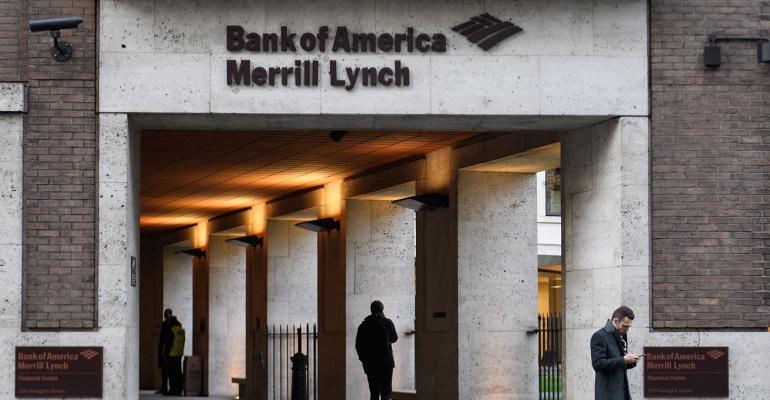Bank of America Merrill Lynch hit record levels in 2020, according to earnings released Tuesday. The New York wealth management firm reported an increase in client deposits, balances and assets under management as it ramped up its web-based services for clients.
Its client balances rose by 10% year over year to $3.3 trillion. Though its private banking balance fell in 2020, the global wealth management unit had a 9% uptick. Assets under management sat at $1.4 trillion, up from $1.28 trillion in 2019.
Positive market valuations and client flows increased deposits year over year by $50 billion to $306 billion. And average assets under management flows reached $20 billion.
One of the ways Merrill advisors beat the pandemic-related odds was by onboarding around 22,000 net new client households with an average size of $1.4 million.
“When you look at 2020 and what was happening in the course of 2020, we saw gross household acquisition in the fourth quarter was the same as the acquisition in first quarter,” said a senior Merrill executive. “The rebound was quite strong.”
The figure is lower than 2019’s, which was 35,000, but considering 2018 was 29,000, 2017 was 5,800 and 2016 was 1,700, it’s relative to the pace of household acquisition, the company stated.
In its Southern Gulf Coast market, which includes states like Alabama and North Florida, Merrill advisors collectively acquired 640 net new households, more than doubling what it’s done in previous years.
Seventy-nine percent of its advisors achieved higher production last year and two out of three saw 2020 as a record year, added the senior exec.
Merrill credited its acquisition success to increasing activity levels in the market, clients’ willingness to move their assets and the way advisors handled a pivot to virtual processes.
Seventy-seven percent of its clientele used the firm’s online or mobile platforms. Advisors held a record 137,000 WebEx meetings with clients—eight times the volume it produced in 2019—and engaged in in-app messaging that amounted to more than 400,000 secure messages exchanged between advisors and their clients. And half of eligible checks were deposited through its automated services, according to its earnings report.
Merrill anticipates that it will continue to see growth, even if symptoms of the pandemic diminish, because both advisors and clients are more familiar with videoconferencing and other web-based services than they were pre-pandemic.
The senior Merrill exec also shared that the firm leverages Bank of America’s annual $3 billion worth of technology upgrades to make things a bit smoother for advisors. Last summer, it launched a new version of Merrill Personal Wealth Analysis, a software financial planning tool that shaved an hour or two off advisors' work days, generated approximately 36,000 reports from clients and brought over new assets from 40% of Bank of America customers.
The state of its advisor force is stable, said a Merrill exec about its 17,331 net advisors in the fourth quarter. That said, more than 400 left that quarter, causing a 2% reduction compared with the previous quarter. Year over year, Merrill lost 1% of its advisors. The exec added that many of those who left had three or more firms on their resume, hinting that they weren’t lifers and more likely to leave.
Merrill’s Financial Advisor Development Program (FADP) was recently cast into the spotlight when Business Insider reported that Merrill had paused trainees’ cold-calling because newbies were repeatedly violating do-not-call restrictions. The senior exec did not comment on the violations but shared that the program would be altered to rely less on cold-calling. FADP has also been extended to give trainees more time to build their clientele so its graduation rates will be low in the short term.
“The grad rates—by design—have been lower because what we have done is really extend the runway for new advisors to give them more time to build their client base. We are extending the time that they are supported with a salary by the company, so there is an investment, “ a senior exec said.
Bank of America beat earnings estimates. It reported $0.59 while analysts predicted 4 cents less. The bank’s revenue fell 1% to $20.1 billion, and its net income rose by 12% to $5.5 billion.





